Lo is a cached allocator that splits the keyspace into large chunks, typically based on some machine word size, rather than the meaningfully-sized ranges (eg obtaining 200 keys at a time) which a human might sensibly choose.
Hi-Lo usage tends to waste large numbers of keys on server restart, and generate large human-unfriendly key values.
Better than the Hi-Lo allocator, is the "Linear Chunk" allocator. This uses a similar table-based principle but allocates small, conveniently-sized chunks & generates nice human-friendly values.
create table KEY_ALLOC (
SEQ varchar(32) not null,
NEXT bigint not null,
primary key (SEQ)
);
To allocate the next, say, 200 keys (which are then held as a range in the server & used as needed):
select NEXT from KEY_ALLOC where SEQ=?;
update KEY_ALLOC set NEXT=(old value+200) where SEQ=? and NEXT=(old value);
Providing you can commit this transaction (use retries to handle contention), you have allocated 200 keys & can dispense them as needed.
With a chunk-size of just 20, this scheme is 10x faster than allocating from an Oracle sequence, and is 100% portable amongst all databases. Allocation performance is equivalent to hi-lo.
Unlike Ambler's idea, it treats the keyspace as a contiguous linear numberline.
This avoids the impetus for composite keys (which were never really a good idea) and avoids wasting entire lo-words when the server restarts. It generates "friendly", human-scale key values.
Mr Ambler's idea, by comparison, allocates the high 16- or 32-bits, and generates large human-unfriendly key values as the hi-words increment.
Comparison of allocated keys:
Linear_Chunk Hi_Lo
100 65536
101 65537
102 65538
.. server restart
120 131072
121 131073
122 131073
.. server restart
140 196608
Design-wise, his solution is fundamentally more complex on the number-line (composite keys, large hi_word products) than Linear_Chunk while achieving no comparative benefit.
The Hi-Lo design arose early in OO mapping and persistence. These days persistence frameworks such as Hibernate offer simpler and better allocators as their default.
